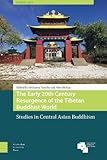The Early 20th Century Resurgence of the Tibetan Buddhist World : Studies in Central Asian Buddhism / ed. by Alex McKay, Ishihama Yumiko.
Material type: TextSeries: Global Asia ; 13Publisher: Amsterdam : Amsterdam University Press, [2022]Copyright date: ©2022Description: 1 online resource (258 p.)Content type:
TextSeries: Global Asia ; 13Publisher: Amsterdam : Amsterdam University Press, [2022]Copyright date: ©2022Description: 1 online resource (258 p.)Content type: - 9789048553068
- Buddhism -- 19th century -- Asia, Central
- Buddhism -- 20th century -- Asia, Central
- Buddhism -- Asia, Central -- History -- 19th century
- Buddhism -- Asia, Central -- History -- 20th century
- Dalai lamas -- History -- 19th century
- Dalai lamas -- History -- 20th century
- Asian Studies
- Asian history
- Buddhism
- Central Asia
- East Asia and North East Asia
- East Asia, Far East
- History of religion
- Religion and Theology
- POLITICAL SCIENCE / Political Process / General
- Buddhist modernity, Central Asia, Tibet
- 294.309514 23
- BQ574 .Y86 2022
- online - DeGruyter
| Item type | Current library | Call number | URL | Status | Notes | Barcode | |
|---|---|---|---|---|---|---|---|
 eBook
eBook
|
Biblioteca "Angelicum" Pont. Univ. S.Tommaso d'Aquino Nuvola online | online - DeGruyter (Browse shelf(Opens below)) | Online access | Not for loan (Accesso limitato) | Accesso per gli utenti autorizzati / Access for authorized users | (dgr)9789048553068 |
Frontmatter -- Table of Contents -- Preface -- Introduction -- 1. The Impact of the Thirteenth Dalai Lama’s Sojourn in Mongolia -- 2. The Modern and Traditional Diplomacy of the Thirteenth Dalai Lama During His Sojourn in Khalkha and Qinghai (1904–1907) -- 3. Friendship and Antagonism -- 4 The Tibet-Mongolia Political Interface in the First Half of the Twentieth Century -- 5. A Study of three Tibetan letters attributed to Dorzhiev held by the St. Petersburg Branch of the Archive of the Russian Academy of Sciences -- 6. Russian Archival Documents on the Revitalization of Buddhism Among the Kalmyks in the Late Nineteenth and Early Twentieth Centuries -- 7. Buddhist Devotion to the Russian Tsar: The Bicultural Environment of the Don Kalmyk Sangha and Russian Orthodox Church in the 1830s -- 8. Russian Tsar as Cakravartin -- 9 The Struggle between Tradition and Modernity in the Early Twentieth Century of the Tibetan Buddhist World -- Index
restricted access online access with authorization star
http://purl.org/coar/access_right/c_16ec
The Early 20th Century Resurgence of the Tibetan Buddhist World is a cohesive collection of studies by Japanese, Russian and Central Asian scholars deploying previously unexplored Russian, Mongolian, and Tibetan sources concerning events and processes in the Central Asian Buddhist world in the late 19th and early 20th centuries. Set in the final days of the Qing empire when Russian and British empires were expanding into Central Asia, this work examines the interplay of religious, economic and political power among peoples who acknowledged the religious authority of Tibet's Dalai Lama. It focuses on diplomatic initiatives involving the 13th Dalai Lama and other Tibetan Buddhist hierarchs during and after his exile in Mongolia and China, as well as his relations with Mongols, and with Buriat, Kalmyk, and other Russian Buddhists. It demonstrates how these factors shaped historical processes in the region, not least the reformulations of both group identity and political consciousness.
Mode of access: Internet via World Wide Web.
In English.
Description based on online resource; title from PDF title page (publisher's Web site, viewed 01. Dez 2022)


